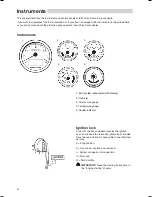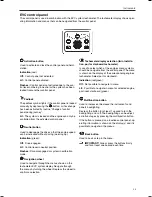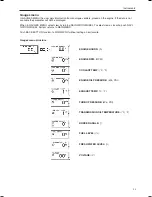
The EVC
EC
system
The Electronic Vessel Control (EVC) system is a so
called distributed system. The principle of a distrib-
uted system is to have "small" electronic units, called
nodes, located at suitable places in the boat.
The EVC nodes are the Powertrain Control Unit (PCU)
and the Steering Helm station Control Unit (SHCU).
Nodes are located close to the components they con-
trol. A helm node is located close to the helm. A pow-
ertrain node is mounted in the engine room.
Each node controls a number of adjacent compo-
nents, such as sensors, controls, instruments and
actuators.
Each PCU and HCU is programmed for a specific
engine. There is a sticker with serial no. and chassis
no. on each PCU and HCU. The chassi no. must cor-
respond with the sticker on the engine.
A data bus, a CAN bus, connects the nodes to each
other. Together they form a network and exchange
information and take advantage of each others’ ser-
vices. The principle of forming a network of nodes to
which all components are connected reduces wiring
radically. A CAN bus can be very long, but in the EVC
system the bus length shall not exceed 50 meters.
CAN stands for Controller Area Network, an industry
standard for communication between nodes in distrib-
uted systems.
A distributed system supports a growing multiplicity
of system configurations and optional features. New
nodes can be connected to the network with minimal
wiring redesign. New effective functionality can be cre-
ated by letting the nodes interact and combine their
capabilities, creating a more useful and safe product.
Functionality
Steering system
The steering system is operated through the EVC
system and gives a smooth and exact steering. It also
provides possibilities, which are not possible with a
traditional steering system.
The helm steering unit sends an electrical signal via
the EVC system to the servo unit fitted on the drive-
unit.
The steering is progressive and the turn rate auto-
matically adjusted to suit the actual boat speed for
optimised comfort and boat handling.
For reliability the steering system is built with redun-
dancy on several levels.
Engine speed and gear shift
Speed and gear shift contol is handled electronically
with dual function electronic controls.
Multiple helm stations
Up to four helm stations can easily be installed (plug
in). The EVC system provides different options for sta-
tion transfers in neutral position or under way. Another
safety feature is a helm station "lock function" to avoid
unexepted station transfers.
Engine synchronization
Engine synchronization results in better comfort, good
fuel ecomomy and minimized wear due to less vibra-
tion and reduced noise level. The master (port) and
slave (starboard) systems must be able to communi-
cate to allow synchronization. For this reason a syn-
chronization cable must be installed at each helm.
Instrumentation
The instruments use a serial communication bus. The
serial communication bus in combination with EVC
radically reduces wiring and simplifies installation.
Gauges are available with white or black dial face and
chromed or black bezel.
EVC system tachometer
The EVC system tachometer is mandatory for boats
with EVC, unless the optional EVC system display
is installed. The tachometer display shows operation
information, information massages and alarms. The
user selects what operation information to display with
the control panel.
NOTE!
Only one operation informa-
tion can be displayed at one and the same time.
The EVC system tachometer and control panel is also
used when calibrating EVC functions.
Extra optional equipment
EVC system display
The EVC system display is a complement or replace-
ment for EVC system tachometer and optional instru-
ments. The display shows operation information, infor-
mation massages and alarms. The user selects what
operation information to display with the buttons on
the display. The EVC system display can display more
than one operation information at one and the same
time. The display also has access to the same display
mode and calibration functions as for the EVC system
tachometer display.
16
Presentation
Summary of Contents for IPS 350
Page 1: ...OPERATOR SMANUAL VOLVO PENTA IPS 350 400 450 500 600 ...
Page 59: ...Turn Rotate Diagonally 57 Operation ...
Page 115: ...Notes 113 ...
Page 116: ...Notes 114 ...
Page 122: ......
Page 123: ......
Page 124: ...7747996 English 06 2007 ...
















































